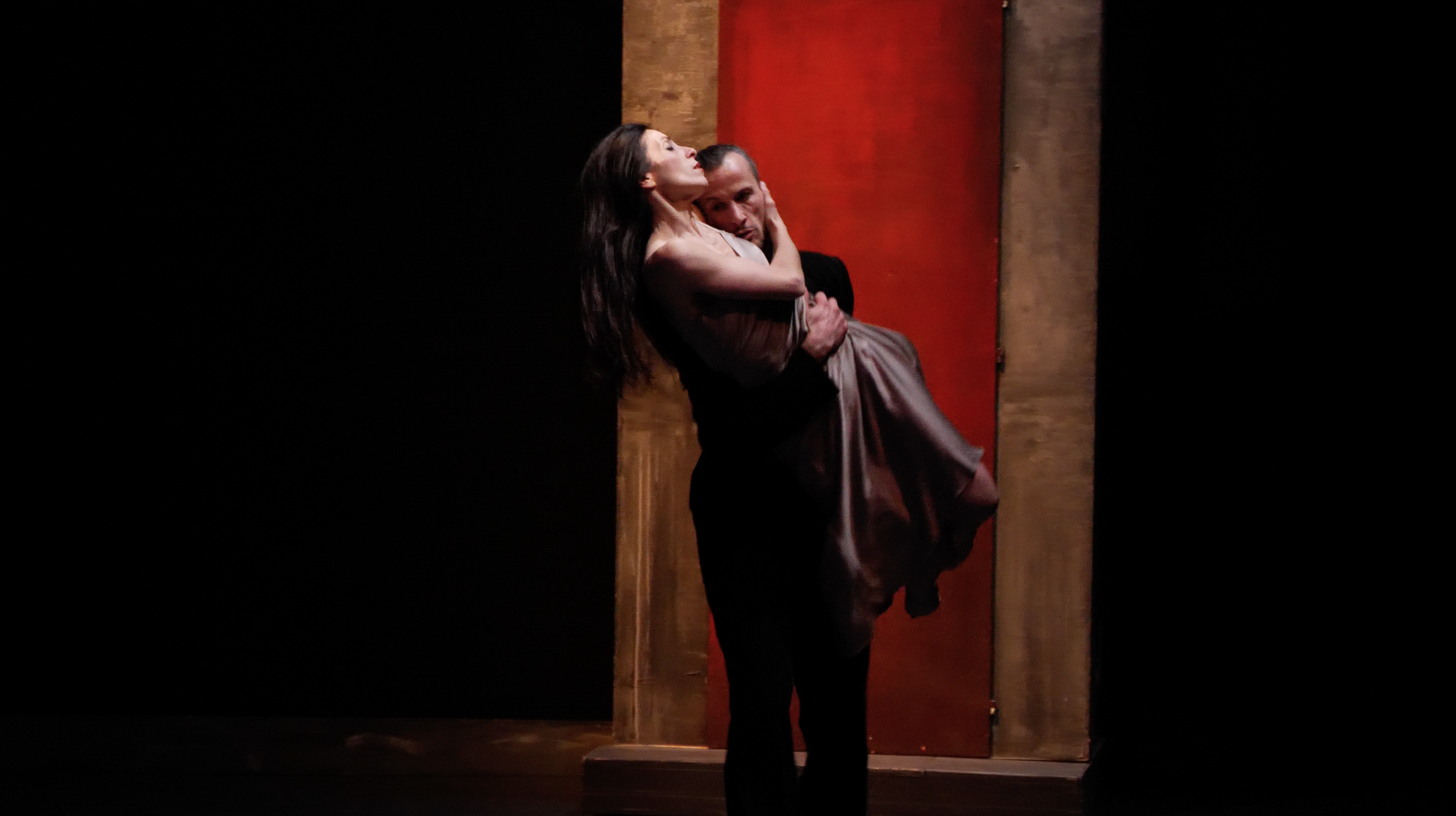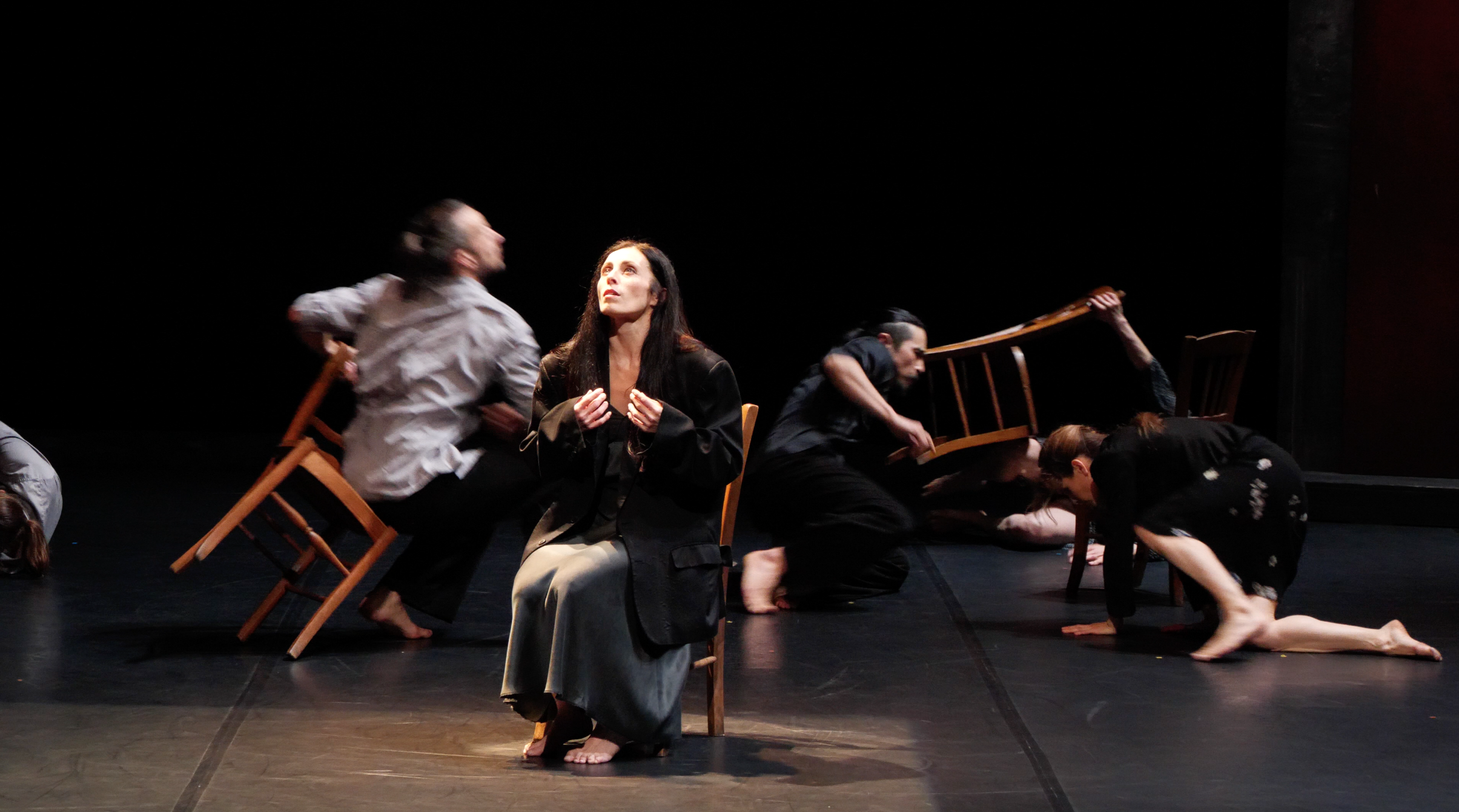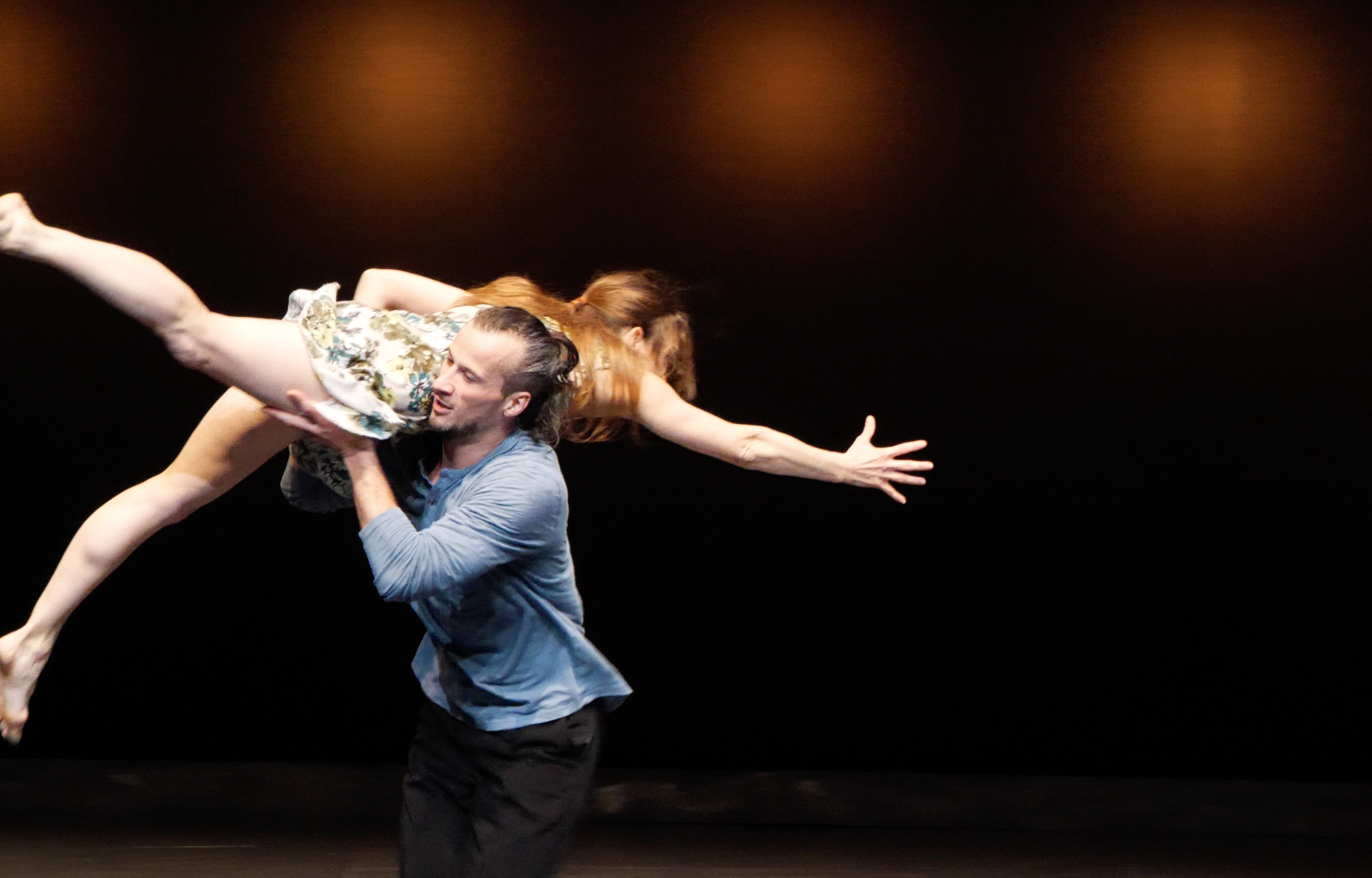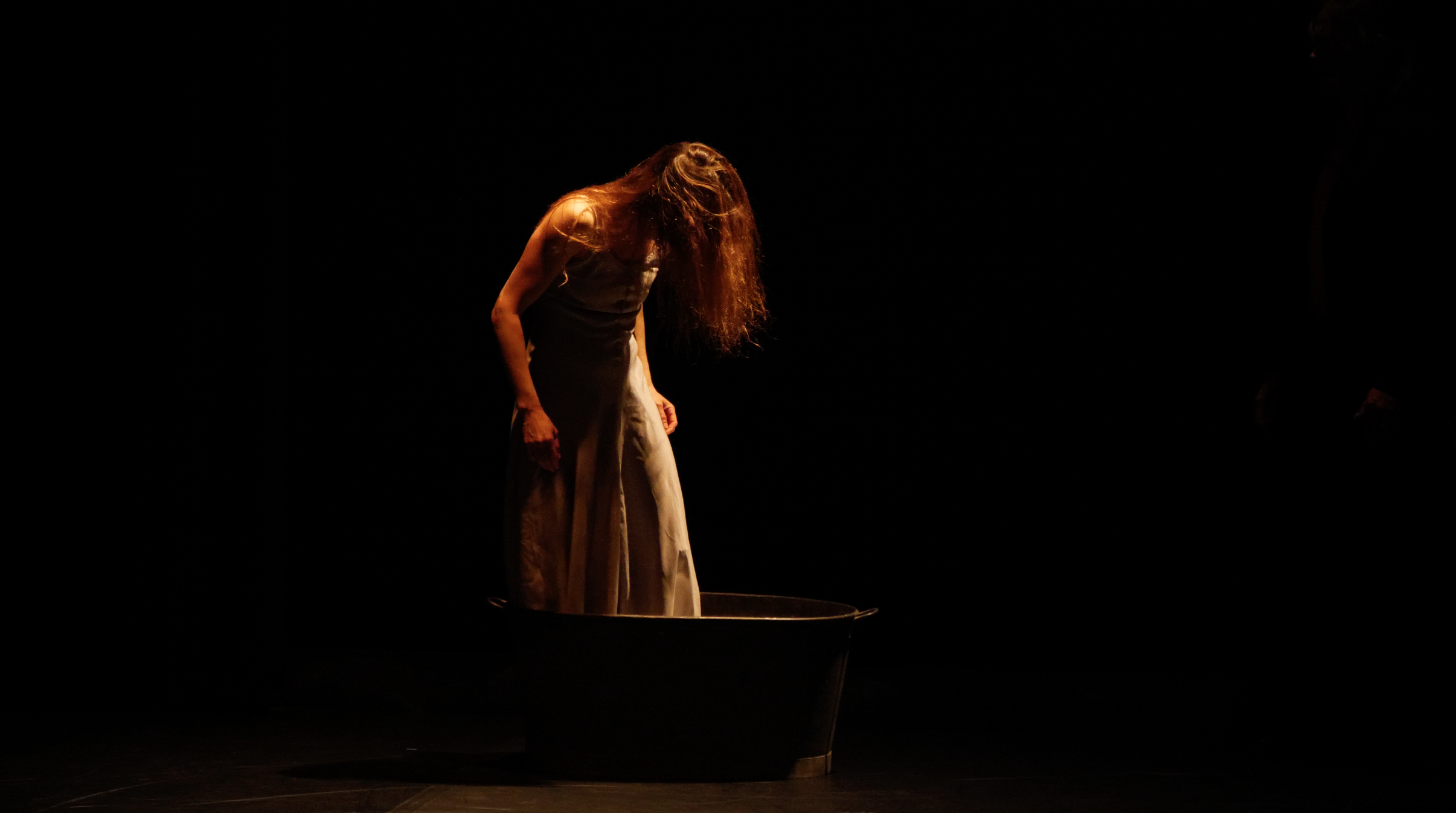Crossroads to Synchronicity
Walking is falling front
Yesterday night the Carolyn Carlson Dance Company from Roubaix, France, made there guest performance “Crossroads to Synchronicity“ at Fabrik Stahlbau Strang – the best place for this choreographic view in between the times.
nightreview by Melanie Suchy
translated by Karoline Strys
Three women are each pushing table forward, tramping: burdens tucked to their bellies. Squeezed together those tables become one long table – but not for a jolly feast as the dished up plates turn out to be terrifying mirrors – nobody will get full here. The women land on the tabletop like slayed, dead, lifeless, later they are siting on their chairs while the heads drop down under the hands of three caring men,- incredibly heavy or not to get awake. In such a way Carolyn Carlson portraits suffering women just before the ending of “Crossroads to Synchronicity“ which makes a bit fretful. But maybe this gloomy and unsettling moment – despite the declared optimist Carlson – delivers a warning to the present: better stay awake, let yourself be shaken and take risks instead of putting the head idly on the tabletop.

Carolyn-Carlson-Crossroads-to-Synchronicity©TANZweb.org
She might as well be, as nothing is too definite with the choreographer born in California in 1943, referring to a time of sorrow or psychiatrically treated depression when those figures in their overlong coats are not quite themselves. Low hanging faces covered by hair can be spotted at various sections in the choreography. In the end follows – whatever “following“ means – a lonely, petrified man with a wedding ring at the table, a woman approaches him, passes him. All of this, you think suddenly, was actually the beginning of the “crossing of synchronicity“. This term stands for the arbitrary interpretation of the experience of time; the perception of sense and relation in actually random, “synchronous“ events as the psychoanalytic Carl Gustav Jung suggests.
The piece from 2017 – an overhaul of “Synchronicity“ from 2012 and created by Carlson in collaboration with the dancers – refers to, as announced, personal, collective and specifically US-American memories. They emerge and pass by, perhaps as constant changes, as wandering scenes, a kind of cure against this unfortunate standstill, against sitting still.

Therefore you need windows and above all doors so that nobody stays where he or she is. Through the window at the top of the back wall people seem to gaze at the theater while later you observe yourself how people are jumping, falling and standing in this paper flurry. In black and white: it it the past? In slow motion: another reality? Doors there are quite a few on stage. But the choreographer does not use them for simple in and outs.
Those things wander by themselves, they glide as if the houses had released them from their duty. The three female and three male dancers flit and live in between them, they let themselves be passed or swallowed by them, they make them the background, walk with them like companions, forwards and sometimes backwards. At times individuals observe and just let things happen. Via simple means the choreographer is presenting how reviews and the present time can interlace, how they “cross“, namely in a gentle and nonchalant manner and come along without a Bluebeard threat.

Big drama as extreme and screaming expression of emotion is anyway just not Carlsons thing. She stylizes it, translates it. She sees herself as a poet – which she is as a writing person. For spectators who are used to Tanztheater this moderation might be irritating here and there. You need to know how to read her. At one point a man rams a woman with his hands against the wall, then she shortly throws her arms around his neck, again ramming, then again hugging until he carries her away. She is kicking. When afterwards a really joyful and dynamic dance scene follows with women in short dresses – instead of the usually long and colorless ones – one might see jaunty children and adolescents in them, maybe the descendants, maybe the next generation with swinging pairs almost like in rock’n’roll.

The scenes change smoothly, just like the focus, almost cinematic. It seems to highlight or extract single dancers occasionally or for the moment of the more extensive or more proximal solo. And then again suddenly two, three or all dancers synchronize for a choreography in unison reassuring themselves with their colleagues with short side looks.
The dance style is characterized by a flowing mode, an imperative of modern dance and – by self-disclosure – the personal preference of the choreographer. Merce Cunningham was responsible for the airy, Pina Bausch for the earthy as Carolyn Carlson explained in interviews. When her dancers keep on running front, back and again front and reaching out far with their hands as if they wanted to get somewhere through or as if they hit against glass. And when they spread their fingers then they never overstretch their limbs, these actions stay indications rather. The dancers plod around searching in the room, they seek to find their balance again and again, topple, catch each other or are caught by the others, they scurry on tiptoes like on a track or rope. But: All is dance, not imitation.

Also with the too frequent scenes with chairs that are brought on and off and that generate an old-fashioned flair, the reductive principle becomes apparent: there the female dancers sit, crossed legs, chin placed on the hand, they stroke the hair back behind their ears. But when they dance afterwards it is not a daily life movement anymore and those moments pass by quickly. Aside from the seemingly trivial furniture – objects like chairs, tables, a table as a bed, a barrel to perch into – the, in Pina Bausch style, alternating pretty musical tracks and songs ranging from Laurie Anderson, Ry Cooder, Tom Waits til Henry Purcell plus railway sounds, the choreography presents mysterious things as well: symbols for spirituality, for something transcendent of the ordinary. This is the immovable dark red door in the background that at first look appears like a big painting by Mark Rothko. The raping lout uses this static thing as a wall. But later the door opens for a (for the?) woman, a crack lets light in, invites her, she disappears. For the others his door stays a promise, a thought – even for the lonely man at the end. A door in front of which they remain standing. Waiting.

Another, downwards directed, perspective reveals the barrel which is temporarily put on stage. It shines at times as well, from underneath, to the faces that hang into it drawn by gravity. An almost ridiculous image. Does it let us peak into the interior of the earth? Into a small fire? Or just onto the bottom of the barrel? Carried and filled wonderfully by the apparently more mature, sensitive dancers, “Crossroads to Synchronicity“ is a very special guest performance also regarding that Carolyn Carlson’s work hardly has been presented in Germany for the past few decades. They are on tour mainly in France and Italy where the choreographer has been working for a long time.

Carolyn-Carlson-Crossroads-to-Synchronicity











